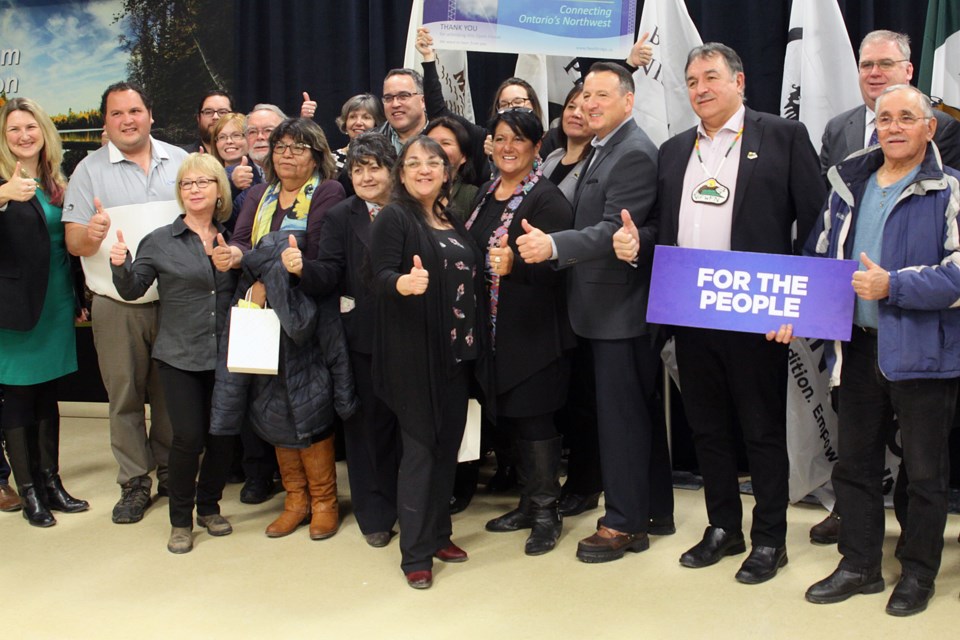THUNDER BAY – The long-cultivated relationship developed with Indigenous communities helped light the way for the decision to choose NextBridge to build its North Shore transmission line.
The province last week issued an order in council directing the Ontario Energy Board to designate NextBridge as the successful proponent to build the East-West Tie, a nearly 450-kilometre line between the Wawa and Lakehead transfer stations.
Despite being initially selected as the proponent in 2013, the project was reopened when estimated costs nearly doubled over the following four years. That led Hydro One to launch a late challenge, attempting to take control of the project last year.
Greg Rickford, the province’s minister of energy, northern development and mines, as well as Indigenous affairs, said Indigenous leadership, the project being shovel ready and the job opportunities that were going to be lost made the NextBridge proposal the more favourable option.
“It was an opportunity for a partnership that had proven itself over and over again,” Rickford said at a Wednesday news conference at the Fort William First Nation community centre, celebrating the announcement.
“This is the kind of leadership from Indigenous communities that we’re looking for. We’re sending a strong signal across Northern Ontario, across Northwestern Ontario, that if Indigenous communities are in the mood to lead major projects, we’ve got more that we want to work on. We’re looking for that kind of leadership and we saw it in this project. It was time to move on with it.”
The six First Nations communities along the north shore of Lake Superior formed the Bamkushwada consortium, which gives them a 20 per cent equity stake in the $767 million project. As well, those communities have formed an economic development entity to pursue contracting and training opportunities connected to the line’s development.
Fort William First Nation chief Peter Collins, who is also the president of Bamkushwada, said he believes that partnership gave NextBridge the advantage.
“We’ve done a lot of work and a lot of hard pushing with NextBridge to understand our rights, our land and our territories. It took a lot of work for them to understand that and to accept that concept,” Collins said.
“It’s a great opportunity for us and the industry to learn from.”
The economic development entity – Supercom Industries – has already trained more than 200 community members to prepare them for employment opportunities.
Collins said those trainees had been expecting to get to work last fall, before the project went sideways.
“The opportunity to go to work in November, that didn’t happen,” Collins said. “It’s always hard to tell people I promised you that you’re going to be working in November, and then it doesn’t happen. That’s the hurtful part of it and that was the impact. The people that did all the training didn’t get to go to work in November.”
NextBridge project director Jennifer Tidmarsh, who was honoured with the presentation of a blanket by community members, recognized the importance of the partnership with the Indigenous communities.
“Any project that needs to be done of this magnitude in this area needs to have relationships,” Tidmarsh said. “It needs to have Indigenous relationships, municipal relationships, government relationships and all of that work in five years and the fact this project is now part of this partnership is just fantastic.”
Tidmarsh said the Ontario Energy Board had requested a 2021 in-service date to accommodate required station work.
A segmented construction has been developed, which takes into account caribou season and other environmental factors, with work most likely starting toward Wawa and moving west.
The transmission has long been seen in the region as a vital step to unlocking the potential for new economic opportunities.
“It’s been quite a long time since the Northwest has had a project of this size,” Tidmarsh said. “I think this kick starts quite a few projects. Everyone I’ve talked to – all of the municipal mayors and councillors – all have ideas of plans going forward for mining and forestry projects. I think this has really inspired them to start moving and pushing.”
